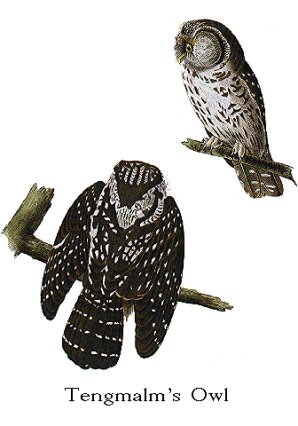
|
Family III. STRIGINAE. OWLS.
GENUS II. ULULA. NIGHT-OWL. |
Next >> |

Family |
TENGMALM'S OWL. [Boreal Owl.] |
| Genus | ULULA TENGMALMI, Gmel.
[Aegolius funereus.] |
I procured a fine male of this species at Bangor,
in Maine, on the Penobscot river, in the beginning of September, 1832; but am unacquainted with its habits, never having seen another individual alive. Mr. TOWNSEND informs me
that he found it on the Malade River Mountains, where it was so tame and
unsuspicious, that Mr. NUTTALL was enabled to approach within a few feet of it,
as it sat upon the bushes. Dr. RICHARDSON gives the following notice respecting
it in the Fauna Boreali-Americana:--"When it accidentally wanders abroad in the
day, it is so much dazzled by the light of the sun as to become stupid, and it
may then be easily caught by the hand. Its cry in the night is a single
melancholy note, repeated at intervals of a minute or two. Mr. HUTCHINS informs
us that it builds a nest of grass half way up a pine tree, and lays two white
eggs in the month of May. It feeds on mice and beetles. I cannot state the
extent of its range, but believe that it inhabits all the woody country from
Great Slave Lake to the United States. On the banks of the Saskatchewan it is
so common that its voice is heard almost every night by the traveller, wherever
he selects his bivouac."
STRIX TENGMALMI, Tengmalm's Owl, Swains. and Rich. F. Bor. Amer.,
vol. ii. p. 94.
TENGMALM'S OWL, Strix Tengmalmi, Aud. Orn. Biog., vol. iv. p. 559.
General colour of upper parts greyish-brown, tinged with olive; feathers of
the head with an elliptical central white spot; those of the neck with a larger
spot; scapulars with two or four large round spots near the end, and some of the
dorsal feathers and wing-coverts with single spots on the outer web; all the
quills margined with white spots on both webs, arranged in transverse series,
there being six on the outer web of the third; on the tail five series of
transversely elongated white spots. Disk yellowish-white, anteriorly black;
ruff yellowish-white, mottled with dusky; throat brown, chin white; lower parts
yellowish-white, longitudinally streaked with brown; some of the feathers of the
sides with two white spots; tarsal and digital feathers greyish-yellow, with
faint transverse brown bars.
Male, 11, wing 6 10/12. Female, 12.
| Next >> |